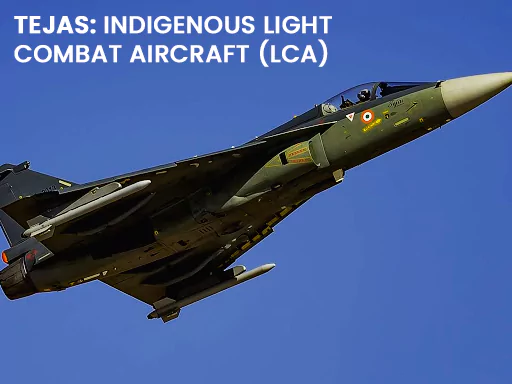Context
Recently the Cabinet Committee on Security (CCS) has cleared a Rs 15,000 crore project to design and develop the Advanced Medium Combat Aircraft (AMCA), India’s fifth-generation multirole fighter jet.
About Advanced Medium Combat Aircraft
- Multirole Fighter Jet: Advanced Medium Combat Aircraft (AMCA) is India’s fifth-generation fighter multirole fighter jet.
- Size: This aircraft will be bigger than other fighters in the Indian Air Force inventory.
- Fifth Generation Aircraft: The aircraft will put India in a select group of nations that have their own fifth-generation fighter aircraft.
- Organizations involved
-
- Aeronautical Development Agency (ADA) & Hindustan Aeronautics Limited (HAL)
Features of Advanced Medium Combat Aircraft:
- Stealth: The 25-tonne twin-engine aircraft will have advanced stealth features to avoid detection by enemy radar.
- Fuel & Weapons: The Advanced Medium Combat Aircraft will have a large, concealed internal fuel tank of 6.5-tonne capacity, and an internal weapons bay for a range of weapons, including indigenous weapons, to be buried in its belly.
- Engine Specifications: The AMCA Mk1 variant will have the US-built GE414 engine of the 90 kilonewton (kN) class.
- The more advanced AMCA Mk2 will fly on the more powerful 110kN engine.
- This will be developed indigenously by DRDO’s Gas Turbine Research Establishment (GTRE) in collaboration with a foreign defence major.
- Specialized Design Features: To maximize engine performance and reduce radar emissions, the AMCA will use cutting-edge design elements like a serpentine air intake duct and a diverterless supersonic inlet.
Significance of Advanced Medium Combat Aircraft:
- Boost to Self Reliance (Atmanirbgarta): After India withdrew from its Fifth Generation Fighter Aircraft (FGFA) partnership with Russia in 2018, the AMCA project highlights India’s pursuit of self-reliance in defense technology.
- Advantages of Stealth: As a fifth-generation fighter, the AMCA will have a low electromagnetic signature, increasing survivability and lethality in modern combat conditions.
- Enhanced Capabilities: Using enhanced sensors and weaponry, the AMCA will be able to detect and engage hostile aircraft while remaining undetected, providing a major edge over fourth-generation equivalents.
- Operational Implications: The IAF’s need for seven AMCA squadrons emphasizes the importance of increasing India’s air combat capability in the face of diminishing fighter squadron numbers.
- Enhancing Strategic Posturing: While countries like the United States, China, and Russia have fifth-generation stealth fighters, the AMCA will add India to this exclusive list, strengthening its strategic position in the region.
- Addressing Operational Gaps: As older aircraft are retired, the induction of AMCA squadrons will fill crucial operational gaps, guaranteeing a capable air combat force in the future.
Stealth Technology
- About: Stealth is the combination of passive low observable (LO) features and active emitters such as low-probability-of-intercept radars, radios and laser designators.
- Features: These are usually combined with active measures such as carefully planning all mission manoeuvres in order to minimise the aircraft’s radar cross-section, since common actions such as hard turns or opening bomb bay doors can more than double an otherwise stealthy aircraft’s radar return.
|
Different Generations of Jet Fighters
- First Generation Fighters: Subsonic fighter planes constructed between the mid-1940s and mid-1950s are considered first generation fighters.
- The planes possessed a basic avionic system, but no radar or self-protection equipment.
- Second Generation Fighters: In contrast to the previous generation of aircraft that carried out their attacks with cannons, machine guns, unguided bombs, and rockets, these jets were capable of reaching supersonic speed and were outfitted with semi guided missiles.
- The most well-known second-generation fighter is probably the MiG-21.
- Third Generation Fighters: The third generation of aircraft, produced in the early 1960s and early 1970s, featured more sophisticated weaponry and maneuverability.
- These aircraft, which included the Mirage III and MiG-23, had the ability to fire at targets that were outside of the pilot’s field of vision.
- Fourth Generation Fighters: Conceptualized in the 1970s, fourth generation fighters went into service in the early 1980s. Additionally, these aircraft had fly by-wire systems installed, which substituted electronic flight control for human combat control.
- The French Mirage 2000, the Soviet MiG29, the American F15, and the French F16 are notable fighters from this generation.
- Fifth-generation multi-role fighters: They have features such as all-aspect stealth, Low Probability of Intercept Radar (LPIR), high-performance airframe, engine capable of supercruise without afterburner,
- The Lockheed Martin F-22 Raptor, the world’s first combat-ready fifth-generation fighter, joined the US Air Force in 2005.
Light Combat Aircraft
- About: The Light combat Aircraft (LCA) is a supersonic, all-weather, multi-role fighter with sophisticated technology for air-to-air, air-to-ground, and air-to-sea warfare. It has a single seat and a single engine.

- Initiation of the Project: The LCA programme was created in 1983. The project definition phase ended in 1989, and the first phase of full-scale engineering development (FSED) was approved in 1993.
- Organizations involved: The Aeronautical Development Agency (ADA) was founded by the government in 1984 to oversee the LCA programme. Hindustan Aeronautics Limited (HAL) is the primary partner, with cooperation from DRDO and CSIR laboratories.
Also Read: Atmanirbharta In Defence Sector
News Source: Indian Express
![]() 11 Mar 2024
11 Mar 2024

